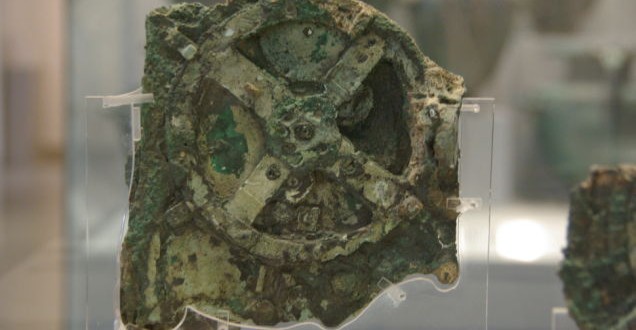Two researchers have conducted a new study trying to better understand the Antikythera Mechanism, an ancient Greek mechanism that modeled the known universe 2,000 years ago. The study, published in the Archive for History of Exact Science, has helped the researchers reveal new clues about the antique Greek astronomical puzzle that has fascinated archaeologists for decades.
After several years of studying the mechanism and Babylonian records of eclipses, the collaborators have pinpointed the date when the mechanism was timed to begin—205 B.C. This suggests the mechanism is 50–100 years older than most researchers in the field have thought.
The new work fills a gap in ancient scientific history by indicating that the Greeks were able to predict eclipses and engineer a highly complex machine—sometimes called the world’s first computer—at an earlier stage than believed. It also supports the idea that the eclipse prediction scheme was not based on Greek trigonometry (which was nonexistent in 205 B.C.)—but on Babylonian arithmetical methods, borrowed by the Greeks.
Far more conjecturally, this timing also makes an old story told by Cicero more plausible—that a similar mechanism was created by Archimedes and carried back to Rome by the Roman general Marcellus, after the sack of Syracuse and the death of Archimedes in 212 B.C. If the Antikythera mechanism did indeed use an eclipse predictor that worked best for a cycle starting in 205 BC, the likely origin of this machine is tantalizingly close to the lifetime of Archimedes.
Evans and Carman arrived at the 205 B.C. date using a method of elimination that they devised. Beginning with the hundreds of ways that the Antikythera’s eclipse patterns could fit Babylonian records (as reconstructed by John Steele, Brown University) the team used their system to eliminate dates successively, until they had a single possibility.
The calculations take into account lunar and solar anomalies (which result in faster or slower velocity), missing solar eclipses, lunar and solar eclipses cycles, and other astronomical phenomena. The work was particularly difficult because only about a third of the Antikythera’s eclipse predictor is preserved.
Evans and Carman first presented their ongoing research at a Netherlands conference in June 2013, stimulating debate among their peers. The new online paper will appear in the journal’s January 2015 hard copy edition.
Agencies/Canadajournal

 Canada Journal – News of the World Articles and videos to bring you the biggest Canadian news stories from across the country every day
Canada Journal – News of the World Articles and videos to bring you the biggest Canadian news stories from across the country every day

